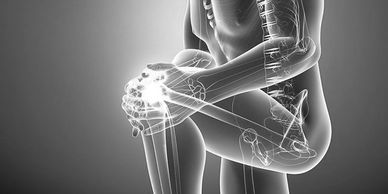- HOME
- Services
- Services Overview
- Physical Therapy
- Physical Medicine
- Occupational Therapy
- Sports Rehabilitation
- Orthotics and Prosthetics
- Electrodiagnostic/NCS/EMG
- Regenerative Medicine
- Steroid Joint Injections
- Pre-Operative Rehab
- Post-Operative Rehab
- Post-Injury /Post-Illness
- Work Injury Rehab
- Worker's Compensation
- Specialty Services
- Social/Psychological Asmt
- Strength & Conditioning
- Personal Training
- Sports Massage Therapy
- Pulmonary Rehabilitation
- Contact Us
- Refer a Patient
- Personal Training
- Career & Partnership Opp.



LEG
HIP AND KNEE
What Are the Common Causes of Hip and Knee Pain?
Although the hip joint is very durable, it can become worn down over time due to age or overuse. As the hip joint becomes more worn down, you are much more likely to experience chronic hip pain. Additionally, a slip and fall can cause the bones in the hip to break and arthritis affects the cartilage in the hip as well.
Some other common causes of hip pain include:
- Bursitis
- Tendinitis
- Hip fractures
- Work injuries
- Tendon or muscle strain
- Certain cancers
- Osteonecrosis
- And more
Like hip pain, knee pain is often associated with the normal aging process or overuse. However, chronic knee pain can also be the result of damage to the bony structures that make up the knee joint like the fibula, tibia, and femur. Damage to the cartilage and ligaments can also send patients to the physical therapist in search of fast pain relief. Other common causes of knee pain include:
- Arthritis (Osteoarthritis, Rheumatoid arthritis, etc.)
- Sports injuries
- Auto accident injuries
- Bursitis
- Torn meniscus
- Medial plica syndrome
Additionally, if the knee joint somehow becomes dislocated due to a sport or work injury, it can result in lasting knee pain.
How Does Physical Therapy Help Treat Hip and Knee Pain?
If you suffer from ongoing hip or knee pain, physical therapy can help to manage your pain while restoring strength and improving your overall mobility. This safe, effective and non-invasive treatment method is also prescription drug-free, making it ideal for patients of all ages. Studies have shown that the manual techniques and mobilizations used in physical therapy can not only reduce hip and knee pain but reduce inflammation, restore your natural range of motion and strengthen the hip and knee joints.
Our physical therapist will work closely with you to design a physical therapy treatment plan that fits your individual needs. By targeting the root cause of your chronic pain instead of simply treating your symptoms, you can enjoy fast pain relief. For better results, our physical therapist may also recommend using both at-home exercises and passive treatments like heat and ice therapy or electrical stimulation to reduce your chronic pain. While other more invasive treatment methods may call for surgery to relieve your hip and knee pain, this holistic treatment option is safe and gentle. In fact, many people who do end up electing to have surgery to correct a hip or knee injury will still need to use physical therapy to recover and reduce pain.
Learn More About the Benefits of Physical Therapy for Hip and Knee Pain
If you or a loved one is suffering from a debilitating hip or knee injury, physical therapy can help! Our experienced physical therapist has the tools necessary to create a tailor-made treatment plan that will quickly help to reduce your pain and support natural healing without the use of prescription pain medications. Get effective knee pain relief treatment. Contact our friendly team online today for more information at Astoria, NY centers or to schedule an initial consultation.
Do you feel pain in your Hips or Knees?
Your hips and knees are the largest joints in your body. While many people may experience hip pain or knee pain on their own, it is also common to experience them together as well. You may first notice hip pain on the outside area of the hip, along the outer buttock or upper thigh area. Hip pain can occur whether you are at rest, walking or during any other type of physical activity. Knee pain is another very common reason why people visit our physical therapists each day. In addition to chronic pain, other common symptoms of knee pain include stiffness, swelling popping and general instability. Many physical therapy patients also find that it is difficult or even impossible to fully straighten the knee as well. If you are experiencing hip pain or knee pain, call our offices today to schedule an appointment with one of our physical therapists.
FOOT AND ANKLE
What is Ankle and Foot Pain?
In short, ankle and foot pain refers to discomfort in the web of bones, ligaments, muscles, and tendons that comprise the foot or ankle. It can impact any area between your toes to your Achilles tendon at the back of your heel and can be long-lasting, in short bursts, or sporadic.
If you’re dealing with such pain, any pressure put on the foot can exacerbate the irritation. Running, jumping, walking, or stretching only amplifies the tenderness, which is an overwhelming motivator for people to pursue treatment.
Causes of Foot and Ankle Pain
Home to one-quarter of the bones in the human body, the foot boasts an impressive number of sensitive spots. There are 26 bones, 33 joints, and more than 100 tendons, ligaments, and muscles in your tootsies, making the likelihood of injury tremendous. From footwear to inflammation, and from injuries to certain medical conditions, your feet are susceptible to pain with nearly every decision you make. And where your foot is involved, so too is the ankle. The foot and ankle go, well, hand in hand.
It’s no wonder then that foot injuries are incredibly common. A misstep, a sudden fall, a sharp object underfoot, and you could suddenly be in a lot of pain.
Here is a short list of some of the most common causes of foot pain:
- Tendinosis
- Stress fractures
- Strains
- Sprains
- Septic arthritis
- Rheumatoid arthritis
- Raynaud’s disease
- Peripheral neuropathy
- Osteoarthritis
- High heels and poorly fitted shoes
- Gout
- Diabetic neuropathy
- Bursitis
- Broken bone
- Bone spurs
- Achilles tendon rupture
- Achilles tendinosis
How Physical Therapy Helps Foot and Ankle Pain
Armed with a skilled physical therapist and a willingness on your part to actively participate in treatment, you can experience a significant decrease in foot pain and eliminate the majority of problems that people have with their feet and ankles. While there are a variety of home remedies, chronic or debilitating pain warrants a trip to a specialist.
The first step to take is to visit your primary care specialist to ensure that there is no risk of further injuring yourself and that an untreated condition such as diabetes isn’t the cause. If your health care provider agrees, your next step is a visit to a physical therapist.
In the realm of physical therapy, a person’s walking pattern is a window into their condition. It serves as a means for physical therapists to ascertain your level of functioning and determine if treatment is working. As such, you can expect a quick evaluation of your walk at every appointment. This will help direct the course of diagnosis and treatment.
Along with this essential element of treatment, a physical therapist will use a variety of tools to help alleviate your pain. This may include massage, stretching techniques, manual manipulation, ultrasound, and different exercises to help build strength and restore mobility while reducing pain.
In addition to the above techniques, your physical therapist may also recommend specialized footwear. Though many of us seek out soft shoes, this tendency plays a huge role in our discomfort. Well-developed orthotics can make a significant difference in your level of foot and ankle pain, and your physical therapist can recommend the most suitable option for you.
If you’re ready to forget pain and want a long-lasting remedy, contact us to schedule an appointment.
Do you feel pain in your Foot and Ankle?
Experiencing foot pain? Is it difficult to walk, exercise, or socialize due to this discomfort? It’s really no surprise. Your feet are some of the hardest working parts of your body. Every day, they serve as shock absorbers and buffer up to one million pounds of pressure as you traverse the world. Moreover, they support one and a half times your body weight when you walk, run, or jump. Approximately 75 percent of Americans will contend with ankle and foot pain at some point in their lives, and if you’re one of them, you know how difficult management can be. Fortunately, you don’t have to be in agony any longer. Physical therapy can help treat the symptoms associated with sprains, strains, and more. Call us today to find out how.
Copyright © 2008 NJPR - All Rights Reserved.
Important COVID-19 Information
As news of the coronavirus (COVID-19) continues to evolve, we are working diligently to keep patients, customers, staff and referral sources safe and updated.
